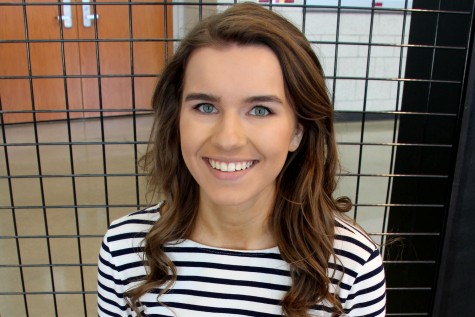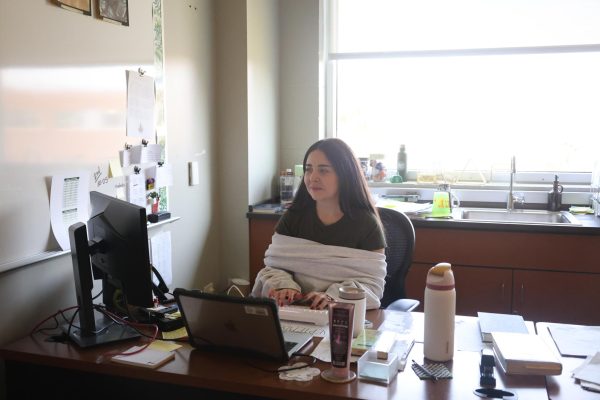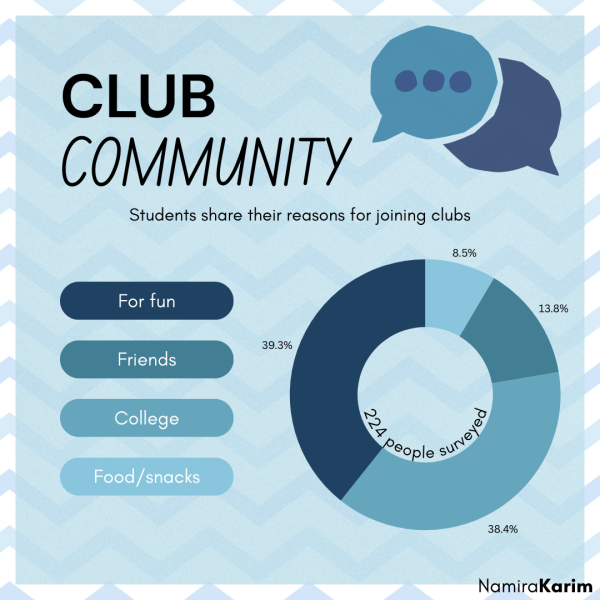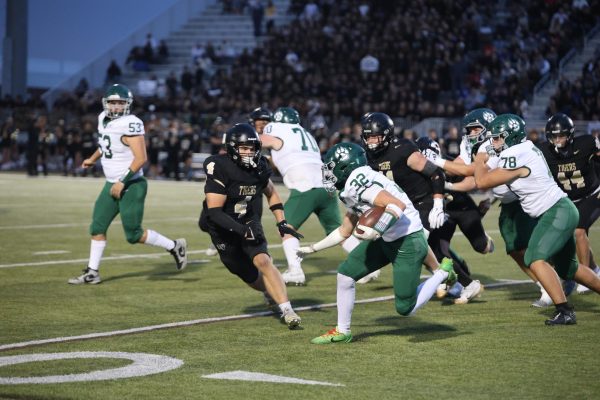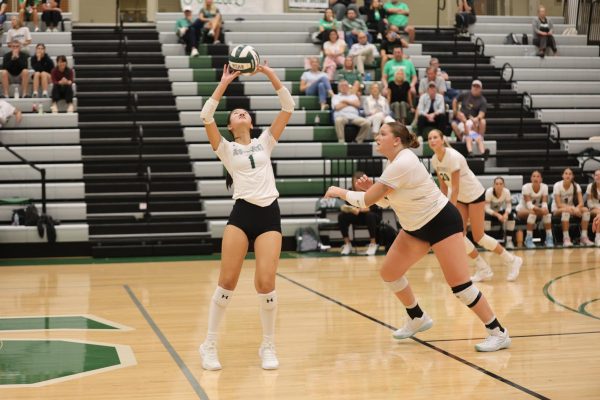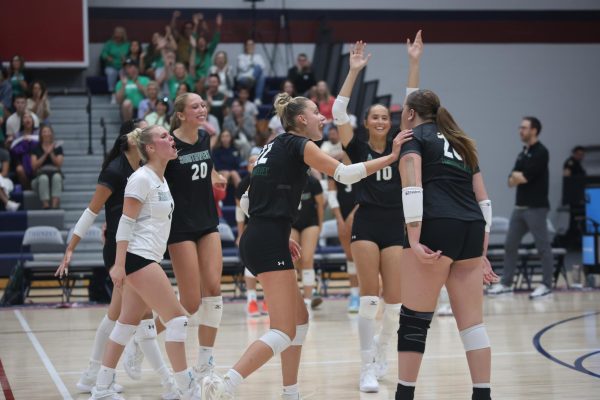Students use experiences from CAPS programs to explore different professions
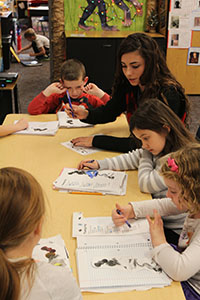
Senior Abby Pelfrey works with students in Elizabeth Hendrix’s first grade class at Morse Elementary on a Thanksgiving-themed project.
Teacher Education
While senior Abby Pelfrey is used to being the student in the classroom, being on the other side of the classroom has given her the unique experience to understand the responsibilities of a teacher. Through the Blue Valley Center for Advanced Professional Studies (CAPS) Teacher Education Program, Pelfrey has learned the duties of a teacher by being enrolled in a program where she spends three hours of each class day preparing for her future profession.
Pelfrey is currently enrolled in her first semester of the program taught by Tammy Fry. While she enjoyed babysitting and tutoring her younger sister, Pelfrey realized that she would potentially want to pursue a career in education, and that the CAPS program would be a good indicator if she was serious about majoring in teaching in college.
“[Teaching] has kind of been my whole life, but these past couple years I’ve been really interested in it and have been looking into it,” Pelfrey said. “I just love little kids. They’re not ‘too cool for school,’ and I like teaching life skills – stuff you use your entire life, instead of just harder math.”
Pelfrey said that an aspect of the Teacher Education program that has confirmed her plans to be a teacher is the shadowing opportunities. In the first semester of the program, Pelfrey is at the Instructor level – the beginning and introductory level of the program. Throughout the course of the semester, Pelfrey was sent out to shadow three different occasions. Pelfrey originally entered the program interested in teaching upper elementary school students, but after completing shadowing opportunities in a sixth grade classroom and kindergarten classroom, she realized that she preferred early elementary school education. Pelfrey completed her last shadowing session in a first grade classroom at Morse Elementary, which she found was the best fit for her.
Fry said the benefit of gaining teaching experiences of different grade levels in a high school level program helps students, like Pelfrey, decide if the grade they had originally been interested in teaching is best suited for them – or if a career in education is something they want to continue pursuing at all.
“We’ve had students who’ve decided that teaching is not for them, and it’s probably better to know that now, rather than after four years of college when you’re a student teacher,” Fry said. “For others, I think [the Teacher Education program] is validation that [teaching] is what they want to do. When they come into the program, the experience that they’ve had is babysitting or being a nanny or maybe tutoring elementary students, but they probably haven’t had a lot of experience with middle school or high school students on the other side as not the student, but from the teacher’s point of view, and I think it’s good for them to see that.”
While many of the students enrolled in the program shadow in classrooms at the elementary, middle and high school levels, the program allows students to explore other sides of the teaching profession. Once students complete the Instructor level, they have the option to continue with the Ed Tech and Gaming program, where students learn how to develop technology and educational games to engage students in learning. Students also have the opportunity to shadow in other professions of the education industry, including occupational therapy, speech therapy and the legal side of the education industry, by working with school resource officers and Youth Court.
“I think a lot of people have the impression that when you say ‘Teacher Education,’ you picture a teacher in front of classroom teaching students,” Fry said.” “[At CAPS], we like to look at it a little different. Yes, that’s an integral part of teaching, but there are so many of facets of education.”
While Pelfrey had intended on attending Kansas State University, the Teacher Education program confirmed her decision to major in education, and she was accepted into the university’s pre-education program. She said that her experiences in different classrooms will better prepare her for her studies, and she has already experienced the stress that a job as a teacher can bring.
“[Teaching] is a lot harder than it looks,” Pelfrey said. “I think a lot of people think it’s an easy job, but it’s a demanding job. You really have to know how to deal with kids, and you have to like kids – that’s something we really focus on at CAPS. Now I definitely know I want to be a teacher. I’m not iffy about it.”
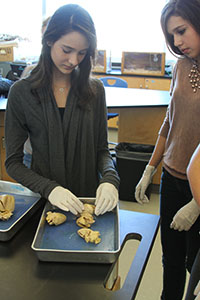
Senior Vanessa Boyd and junior Jessica Bitteker examine the internal body parts of animals during the Veterinary Medicine program’s anatomy unit.
Veterinary Medicine
In Kansas City lies the heart of an area not commonly known for its innovation in veterinary medicinal sciences. The Health Corridor stretches from Manhattan, Kan. to Columbia, Miss., and the companies based in its area generates the products that account for half the worldwide animal health, diagnostics and pet food sales, according to the KC Animal Health Corridor. Because of this, the Blue Valley Center for Advanced Professional Studies (CAPS) added Veterinary Medicine to its course offerings. The program, taught by Kelley Tuel, aims to expose its students to not only careers in the veterinary field, but also in fields of animal care and animal health research.
“When people see our title of the course, they think that we’re only preparing students to be veterinarians,” Tuel said. “But really, so many students might be considering becoming a veterinarian, but they know that they would like a career that has something to do with animals, so the goal of our course is to introduce them to as many possibilities as we can of things they can do in the future with animals, which may or may note be right for them, but just to expose them to things they didn’t know existed before.”
The new course attracted junior Jessica Bitteker, who enrolled in program with a strong interest in a profession as a veterinarian. Tuel said that around a third of her students, including Bitteker, are set on being veterinarians, but the other two-thirds aren’t yet sure of the career regarding animals that they’d like to pursue. Through shadowing opportunities at animal clinics, animal shelters and animal daycare facilities, students are exposed to a variety of careers in the field. Students also get the chance to meet with professionals in different areas of animal health and explore animal health programs at the university level.
“Taking the Veterinary Medicine course has affirmed my decision to be a large animal veterinarian,” Bitteker said. “The experience I had getting to the meet the dean of veterinary medicine at Kansas State University and sitting through an anatomy lecture was very helpful for me, as that is the college I wish to attend.”
Although the class’ schedule varies from week to week, students typically spend three days a week working outside the CAPS building and two days a week inside the CAPS building. The curriculum of the class covers multiple aspects of the animal industry. Students have covered units ranging from food animal reproduction to animal diseases, and each unit students work with experts in the industry, hear presentations from speakers and attend tours of companies specializing in a certain sector of the industry.
“[These opportunities] get students into the situation where they’re really learning about [the animal health industry],” Tuel said. “You might hear a title, but not really know what that entails, so these experiences we’re having with the people who do those careers give them insight as to what their job entails, how the person in the career got to that path and factors they had in considering it.”
Students recently completed a product development project with the Kansas City branch of international chemical and health care company Bayer Pharmaceuticals to develop a mock animal drug. Tuel said that a unique benefit of the Veterinary Medicine program is that not only do students get experience working with international companies in the health industry, but their experiences also establish early-on connections and can lead to future career opportunities.
“[The students] go to college or even college interviews, and they have very specific projects that they’ve worked, so they can give specific examples they did for a company and say, ‘I did this successfully and got this outcome,’ so having the collaborative aspect with these companies is a big differentiator [than high school science classes],” Tuel said.
Bitteker said she has gained invaluable experiences from just one semester in the program, and that the connections she has made with companies and speakers she has worked with during the program have given her knowledge she can utilize when majoring in college, as well as for building up her career in the animal health industry once she graduates.
“It was a blessing to me to be offered this class and the opportunity to dig deeper into veterinary medicine and go beyond what I could learn in the typical classroom,” Bitteker said.
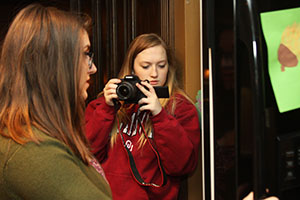
Junior Rylee Brown films senior Erica Christie, who is one of the actors in her short film about a group of friends who mysteriously disappear while playing hide-and-seek.
Filmmaking
Junior Rylee Brown intently keeps her eyes on the screen of her camera. With a steady hand, she aims the camera on her subjects, adjusting the lighting with a twist of the mode dial. For each scene, she closely examines the footage, carefully analyzing the camera angles, lighting and acting in order to decide whether to shoot another take. Although the film will only be a few minutes long, the Center for Advanced Professional Studies (CAPS) Filmmaking program has taught her the importance of each scene and its part in the overall finished product.
Brown enrolled in the Filmmaking course after a recommendation from counselor Kristi Dixon. Brown had taken Broadcast I at the high school and had previous video making experience on YouTube, but she never had the in depth learning experience of a program solely devoted to teaching students about the filmmaking industry and filmmaking techniques. Despite Brown’s limited exposure to the film industry, she had planned to take online school junior year in order to complete her credits and graduate early and then attend film school. However, Dixon had another idea for Brown and suggested that she enroll in the Filmmaking program at CAPS. The creative freedom that the Filmmaking program allows has been a positive experience for Brown, and it caters to the learning style that best fits her.
“[CAPS] has made me like school a lot more,” Brown said. “I was just not a person who enjoyed high school at all. CAPS has given me an outlet to be creative in the morning and then come to school and get my work done. I have to go back and forth so much [between CAPS and Southwest] that I don’t feel like I’m in high school half the time.”
Filmmaking instructor Gina Njegovan said that many students in her class are similar to Brown in the sense that they are ready to move past the filmmaking techniques and projects covered in broadcast classes and move into an in-depth study of the filmmaking industry and learn about potential careers in the field. Through the films that the students produce and through work with film industry professionals, students are exposed to the many sides of the filmmaking business and the numerous potential careers.
“Most of [the students] think that they want to be a director or a cinematographer, but what we learn is, through working with filmmakers, that [the film industry] is a 10-15 year process, and you’re going to start out as a grip,” Njegovan said. “But there’s so many facets, and there are so many people that they aren’t aware of [who work in the industry]. You’ll have 120 people on a production shoot, so we try to really get in there and see those things so they’ll be able to see there’s all these different [components of a production].”
The curriculum of the Filmmaking program is designed so that two-thirds of the projects the students work on are creative projects. In the first semester of the program, students produce a number of short films, including a music video and a narrative. The other third of the curriculum is dedicated toward producing films for businesses and learning the skills of working with clients. Njegovan said that she finds local businesses for students to work with that have serious intentions of using the students’ final products in the future.
“When you work with a client, you have to be able to communicate with that client, and the client is always right,” Njegovan said. “If they don’t like what you’ve done, and they want you to make those revisions, even though you feel those may be not be the revisions that would work best, it doesn’t matter. [The students] have to work to specifications. That’s a skill.”
Brown said that one her favorite aspects of the Filmmaking program is the sense of a family that her morning class has created. In her class, Brown joins students from not only all other Blue Valley high schools, but also students from private schools and home schooled students.
“[My classmates and I] don’t stop spending time with each other,” Brown said. “We hang out after school; we hang out on the weekends. We all get along really well, and we all have different talents, but we all bring those in to make something really cool. That’s what’s really cool about CAPS – we all needed that place to not be at school all the time every day.”
Despite CAPS taking up three hours of her school day, Brown is still on track to graduate at the end of her first semester of senior year. She then plans to begin her studies at the University of Kansas and major in film. Through the CAPS program, Brown has been given the chance to meet with film professors at the school and tour its film program. Brown said that the skills she’s learned and business connections that she’s made will benefit her in college and will also help her when applying for a job after graduation.
“I definitely didn’t know what I wanted to do before I did CAPS,” Brown said. “In a few months it’s made me know that filmmaking is what I need to major in. It’s what I’m passionate about.”


